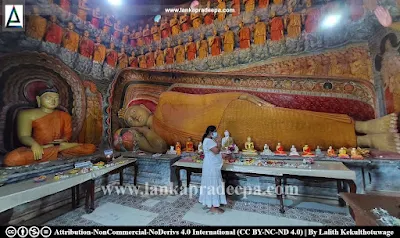
Weligama Agrabodhi Viharaya (Sinhala: වැලිගම අග්රබෝධි විහාරය) is a Buddhist temple situated in Weligama in Matara District, Sri Lanka. The famous Kushtarajagala is located near this temple.
History
There is a reference to this temple in Sinhala Bodhivamsa (Abeyawardana, 2004; Samanthi, 1999; Wikramaratne, 2015). It says that the very first sapling out of the first 32 saplings of the Jaya Sri Maha Bodhi tree at Anuradhapura was planted on this temple premises (Abeyawardana, 2004; Wikramaratne, 2015). As it is the first Bodhi tree sapling, the temple is said to have been known by the name Agrabodhi Viharaya (Wikramaratne, 2015). However, according to another view, this temple is called by that name because of the belief that this temple was built under the patronage of King Aggabodhi IV [(667-683 A.D.) Abeyawardana, 2004]. A verse written by a monk from Aggrabodhi (Agbo) of Weligama has been found among the graffiti in Sigiriya (Abeyawardana, 2004).

Chronicles reveal that a Pirivena or a religious school for Aggrabodhi Viharaya was built at Weligama by a general named Swaraja Kulawardhana Devadhikari during the reign of Queen Kalyanavathi (1202-1208 A.D.) of Polonnaruwa (Abeyawardana, 2004; Nicholas, 1963; Wikramaratne, 2015). The present Rajakulavadana Viharaya which is located close to Aggrabodhi Viharaya is considered by many as the monastic site established by the general (Abeyawardana, 2004). King Parakramabahu IV (1302-1326 A.D.) of Dambadeniya is believed to have erected a two-storied long building named Parakramabahu Pasada at Weligama temple and granted it the village of Saligiri [(present Algiriya) Nicholas, 1963; Wikramaratne, 2015]. There are further records regarding donations made to this temple by King Bhuvanekabahu IV (1341-1351 A.D.) and General Sena Lankadhikara (Abeyawardana, 2004; Ray, 1960).
The temple is believed to have been partially destroyed by the Portuguese who landed in Sri Lanka in 1505 (Abeyawardana, 2004; Samanthi, 1999). They had control of some parts of the island until they were expelled by the Dutch in 1658. The destroyed temple was re-erected by Ven. Agalakada Dhammarakkhita Thera under the patronage of King Kirthi Sri Rajasinghe [(1747-1782 A.D.) Abeyawardana, 2004; Samanthi, 1999; Wikramaratne, 2015]. A stone slab inscription found on the temple premises reveals some donations made to the temple by King Sri Rajadhi Rajasinha (1781-1798 A.D.), and two other chiefs named Seneviratna Korala, Wijesinghe Mudali (Dias, 1991; Ranawella, 2015). This inscription does not belong to the reign of King Rajadhi Rajasinhe and scholars have dated it to the 19-20th century A.D. (Dias, 1991; Ranawella, 2015).
The temple is mentioned in some Sandesha poems, such as Tisara, Paravi, and Kovul (Abeyawardana, 2004; De S. Manukulasooriya, 1978).
Artefacts and other structures
Donations by Sri Rajadhi RajasinhaA golden statue, a casket, a pair of tusks, two Semaras, and two ivory monks' fans are presently preserved in the temple (Wikramaratne, 2015). These are believed to have been donated to the temple by King Sri Rajadhi Rajasinha [(1781-1798 A.D.) Wikramaratne, 2015].
The Ashta-Mangala slab
A rectangular slab of limestone containing symbols of Ashta-Mangala (Eight Auspicious symbols) has been unearthed during an excavation done at a spot near the preaching hall (Karunaratne, 1973).
The Stupa
The Stupa of the temple is said to have been erected in 1890 (Wikramaratne, 2015).
The image house
The two-storied image house contains several Buddha statues in seated, standing, and reclining positions. Images of Sariputta and Moggallana, the two chief disciples of Gautama Buddha are also found. The murals that adorn the inner walls depict features of the Kandyan Art tradition (Wikramaratne, 2015). The image house was completely renovated in 1914 (Abeyawardana, 2004).


.
Attribution
#) LankaPradeepa.com would like to thank Lalith Kekulthotuwage for providing the necessary photographs required for this article. All the photos are published here with the permission of the author.
References
1) Abeyawardana, H.A.P., 2004. Heritage of Ruhuna: Major natural, cultural and historic sites. Colombo: The Central Bank of Sri Lanka. ISBN: 955-575-073-4. pp.54-55.
2) De S. Manukulasooriya, R.C., 1978. Transport in Sri Lanka in ancient and mediaeval times. Journal of the Sri Lanka Branch of the Royal Asiatic Society, 24, pp.49-85.
3) Dias, M., 1991. Epigraphical notes (Nos 1 -18). Colombo: Department of Archaeology. pp.33,35-36.
2) De S. Manukulasooriya, R.C., 1978. Transport in Sri Lanka in ancient and mediaeval times. Journal of the Sri Lanka Branch of the Royal Asiatic Society, 24, pp.49-85.
3) Dias, M., 1991. Epigraphical notes (Nos 1 -18). Colombo: Department of Archaeology. pp.33,35-36.
4) Karunaratne, T.B., 1973. A unique Astamangala relief from Weligama. Journal of the Sri Lanka Branch of the Royal Asiatic Society, 17, pp.46-54.
5) Nicholas, C. W., 1963. Historical topography of ancient and medieval Ceylon. Journal of the Ceylon Branch of the Royal Asiatic Society, New Series (Vol VI). Special Number: Colombo. Royal Asiatic Society (Ceylon Branch). p.72.
6) Ranawella, S., 2015. Archaeological Survey of Ceylon: Inscriptions of
Ceylon: Vol. IX. Department of Archaeology. ISBN: 978-955-9159-98-8.
pp.63-64.
7) Ray, H.C. (Editor in chief), 1960. History of Ceylon: Vol. I: Part II. Ceylon University Press. Colombo. p.641.
8) Samanthi, L.K.N., 1999. Architectural concepts of Buddhist places of worship: an examination of the architectural concepts of Buddhist places of worship in rural and urban settings with special reference to Southern Province. A dissertation submitted to the University of Moratuwa as a partial fulfillment of the requirements for the Degree of Master of Science in Architecture. pp.79-89.
8) Samanthi, L.K.N., 1999. Architectural concepts of Buddhist places of worship: an examination of the architectural concepts of Buddhist places of worship in rural and urban settings with special reference to Southern Province. A dissertation submitted to the University of Moratuwa as a partial fulfillment of the requirements for the Degree of Master of Science in Architecture. pp.79-89.
9) Wikramaratne, I., 2015. Pauranika Sthana Saha Smaraka: Matara Distrikkaya (In Sinhala). Department of Archaeology (Sri Lanka). ISBN: 955-9159-54-2. pp.10-12.
Location Map
This page was last updated on 8 October 2023

